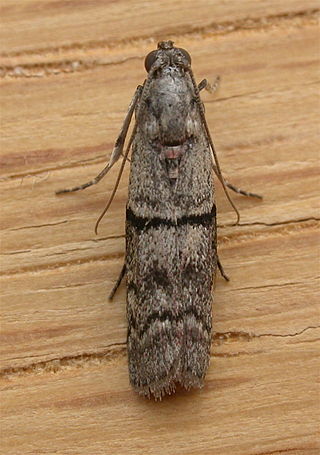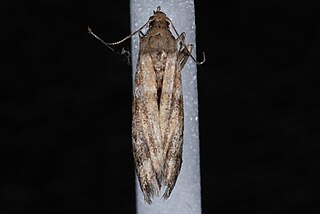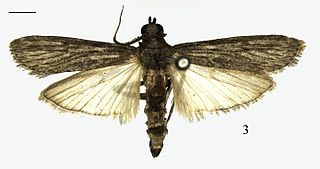
The Pyralidae, commonly called pyralid moths, snout moths or grass moths, are a family of Lepidoptera in the ditrysian superfamily Pyraloidea. In many classifications, the grass moths (Crambidae) are included in the Pyralidae as a subfamily, making the combined group one of the largest families in the Lepidoptera. The latest review by Eugene G. Munroe and Maria Alma Solis retain the Crambidae as a full family of Pyraloidea.

The Phycitinae are a subfamily of snout moths. Even though the Pyralidae subfamilies are all quite diverse, Phycitinae stand out even by standards of their family: with over 600 genera considered valid and more than 4000 species placed here at present, they unite up more than three-quarters of living snout moth diversity. Together with the closely related Epipaschiinae, they are apparently the most advanced lineage of snout moths.
Paticiola is a monotypic snout moth genus in the subfamily Phycitinae described by Carl Heinrich in 1956. Its only species, Patriciola semicana, was described by the same author in the same year. It is known from North America, including Utah.
Acroncosa albiflavella is a species of moth of the family Pyralidae, of the order Lepidoptera. Acroncosa albiflavella was described by William Barnes and James Halliday McDunnough in 1917. It is found in western North America, including New Mexico and California.
Adanarsa is a monotypic snout moth genus in the subfamily Phycitinae. It was described by Carl Heinrich in 1956. It contains the species Adanarsa intransitella, which was originally described as Rhodophaea intransitella by Harrison Gray Dyar Jr. in 1905. It is found in North America, including Arizona, New Mexico and California.
Adelphia is a monotypic snout moth genus in the subfamily Phycitinae. It was described by Carl Heinrich in 1956. Its only species is Adelphia petrella, which was originally described as Pempelia petrella by Philipp Christoph Zeller in 1846. It is found in North America, from New Jersey to Florida and westward to Iowa and Texas.
Elasmopalpus is a snout moth genus in the subfamily Phycitinae described by Émile Blanchard in 1852. The genus is restricted to the Americas and currently comprises three species: the type species E. angustellus, described by Blanchard together with the genus, E. corrientellus Ragonot, 1888, and E. lignosellus, a pest species of Poaceae and Fabaceae crops that is widespread throughout the Americas. Elasmopalpus is considered to be closely related to the genus Ufa.

Cahela is a monotypic snout moth genus described by Carl Heinrich in 1939. Its only species, Cahela ponderosella, the cahela moth, described by William Barnes and James Halliday McDunnough in 1918, is found in Mexico and in the US states of California, Texas, Arizona, Utah and probably Nevada.
Cassiana is a monotypic snout moth genus described by Carl Heinrich in 1956. Its only species, Cassiana malacella, was described by Harrison Gray Dyar Jr. in 1914. It is found in Mexico, the southern United States, the British Virgin Islands Puerto Rico and Bermuda.

The Phycitini are a tribe of moths of the family Pyralidae.
Eremberga is a genus of snout moths in the subfamily Phycitinae. It was described by Carl Heinrich in 1939. Some sources list it as a synonym of Zophodia, while others retain it as a valid genus.

Zophodia is a genus of snout moths in the subfamily Phycitinae. It was erected by Jacob Hübner in 1825.
Homoeosoma striatellum is a species of snout moth in the genus Homoeosoma. It was described by Harrison Gray Dyar Jr. in 1905. It is found in North America, including Arizona, California and Nevada.

Vitula broweri, or Brower's vitula moth, is a species of snout moth in the genus Vitula. It was described by Carl Heinrich in 1956. It is found in much of North America, including British Columbia, Manitoba, Maryland, Massachusetts, Ohio, Oklahoma, Ontario, Tennessee, West Virginia and Wisconsin.
Vitula pinei is a species of snout moth in the genus Vitula. It was described by Carl Heinrich in 1956. It is found in the US states of California, Arizona, Texas and Utah.
Vitula inanimella is a species of snout moth in the genus Vitula. It was described by Harrison Gray Dyar Jr. in 1919. It is found in Mexico and Guatemala.
Macrorrhinia aureofasciella is a species of snout moth in the genus Macrorrhinia. It was described by Émile Louis Ragonot in 1887 and is known from the US states of Arizona and Texas.

Ectomyelois bipectinalis is a species of snout moth. It is found in China.

Ectomyelois furvivena is a species of snout moth. It is found in China.
Ufa is a moth genus in the subfamily Phycitinae of the family Pyralidae. The genus is distributed in the Americas. While sharing certain morphological characters in the female genitalia with Adelphia, Ufa appears closest related to Elasmopalpus.







